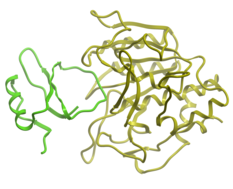Protein Protein Docking Achievements |
 The ICM-Pro protein-protein docking methodology was originally successfully applied to the prediction of an antibody-lysozyme complex [Totrov, 1994] and was later tested in a blind prediction contest [Strynadka, 1996]. The ICM-Pro protein-protein docking methods incorporate a two-step procedure incorporating rigid-body docking followed by ICM side-chain optimization [Fernandez-Recio, 2002; Fernandez-Recio, 2002; Fernandez-Recio, 2003]. Using this method and incorporating solvation with a screened charge electrostatic model it has been tested on a benchmark of 24 protein-protein complexes in which the three-dimensional structures of their subunits (bound and free) were available. The rank of the near-native conformation in a list of candidate docking solutions was <20 in 85% of complexes with no major backbone motion on binding. Among them, as many as 7 out of 11 (64%) protease-inhibitor complexes can be successfully predicted as the highest rank conformations.
The ICM-Pro protein-protein docking methodology was originally successfully applied to the prediction of an antibody-lysozyme complex [Totrov, 1994] and was later tested in a blind prediction contest [Strynadka, 1996]. The ICM-Pro protein-protein docking methods incorporate a two-step procedure incorporating rigid-body docking followed by ICM side-chain optimization [Fernandez-Recio, 2002; Fernandez-Recio, 2002; Fernandez-Recio, 2003]. Using this method and incorporating solvation with a screened charge electrostatic model it has been tested on a benchmark of 24 protein-protein complexes in which the three-dimensional structures of their subunits (bound and free) were available. The rank of the near-native conformation in a list of candidate docking solutions was <20 in 85% of complexes with no major backbone motion on binding. Among them, as many as 7 out of 11 (64%) protease-inhibitor complexes can be successfully predicted as the highest rank conformations.
ICM-Pro has also competed in the worldwide protein-protein docking competition called CAPRI (Critical Assessment of PRedicted Interactions). In 2003 MolSoft was one of the top five groups who provided at least one acceptable prediction for three of the seven targets in the competition along with the laboratories of Camacho, Einsenstein, Sternberg and Ten-Eych. The CAPRI predictions were performed fully automatically with this method on all seven of the targets involved in the competition. Available experimental information was included as a filtering step to favor expected docking surfaces. In three of the seven proposed targets, MolSoft's ICM method found a good solution (>50% of correct contacts) within the five submitted models. The procedure is global and fully automated. We demonstrate that the algorithm handles the induced changes of surface side-chains but is less successful if the backbone undergoes large-scale rearrangements [Fernandez-Recio, 2003]. In subsequent rounds of the CAPRI competition ICM-Pro achieved good models for 8 of the 9 targets and successfully implemented a new scoring function.
Strynadka, N.C.J., Eisenstein, M., Katchalski-Katzir, E., Shoichet, B.K., Kuntz, I.D., Abagyan, R., Totrov, M., Janin, J., Cherfils, J., Zimmerman, F., Olson, A., Duncan, B., Rao, M., Jackson, R., Sternberg, M., and James, (1996) M.N.G. Molecular Docking Programs Successfully Predict The Binding of A Beta-Lactamase inhibitory Protein To Tem-1 Beta-Lactamase. Nature Struct. Biol. 3, 233-239
Fernandez-Recio, J., Totrov, M., and Abagyan, R. ICM-DISCO (2003) Docking by Global Energy Optimization with Fully Flexible Side-Chains Proteins 52:113-117. The ICM Protein-Protein docking method, which ranked highly in the worldwide CAPRI docking competition. See the two papers below by Mendez et al. for evaluation of results.
Fernandez-Recio, J., Totrov, M.M., and Abagyan, R.A. (2002) Soft Protein-Protein Docking in Internal Coordinates Protein Science 11:280-91
Fernandez-Recio J, Abagyan R, Totrov M. (2005) Improving CAPRI predictions: optimized desolvation for rigid-body docking. Proteins. 2005 Aug 1;60(2):308-13.
Fernandez-Recio, J., Totrov, M., Skorodumov, C., Abagyan, R. (2005) Optimal Docking Area: A New Method for Predicting Protein-Protein Interaction Sites. Proteins 57:400-13.
Protein-Protein Docking Assessment:
Mendez R, Leplae R, Lensink MF, Wodak SJ. (2005) Assessment of CAPRI predictions in rounds 3-5 shows progress in docking procedures. Proteins. 2005 Aug 1;60(2):150-69.
Mendez R, Leplae R, De Maria L, Wodak SJ. (2003) Assessment of blind predictions of protein-protein interactions: current status of docking methods. Proteins. 2003 Jul 1;52(1):51-67.